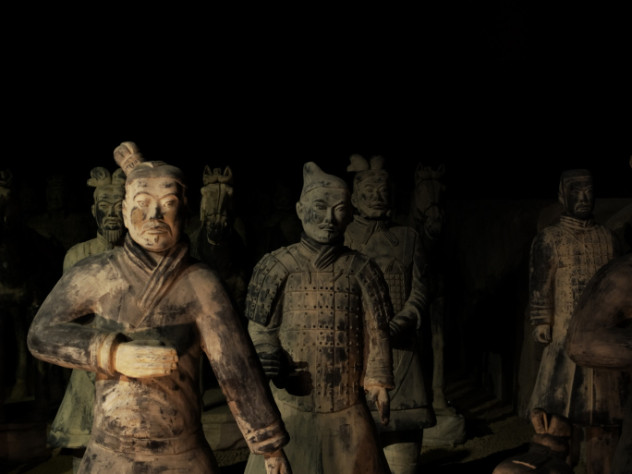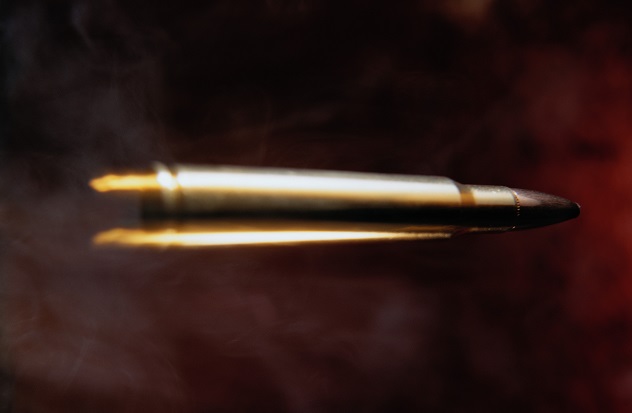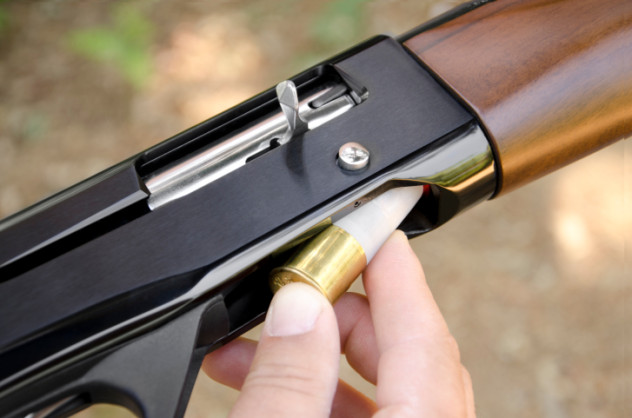 Food
Food  Food
Food  History
History 10 Odd Things Colonial Americans Kept at Home
 Weird Stuff
Weird Stuff 10 Superstitious Beliefs That Once Consumed Entire Cultures
 History
History 10 Bizarre Friendly Fire Incidents in Military History
 Technology
Technology 10 Modern Technologies That Accidentally Imitate Ancient Magic
 Mysteries
Mysteries 10 Mysteries of the Human Genome
 Weird Stuff
Weird Stuff 10 Things So Rare They’ve Only Been Found Once
 History
History 10 Legends Whose Last Moments Undid Their Glory
 Health
Health 10 Futuristic Ideas to Treat Common Medical Problems
 Weird Stuff
Weird Stuff Ten Surreal Attempts to Reverse Baldness
 Food
Food 10 Everyday Foods You Didn’t Know Were Invented by the U.S. Military
 History
History 10 Odd Things Colonial Americans Kept at Home
 Weird Stuff
Weird Stuff 10 Superstitious Beliefs That Once Consumed Entire Cultures
Who's Behind Listverse?

Jamie Frater
Head Editor
Jamie founded Listverse due to an insatiable desire to share fascinating, obscure, and bizarre facts. He has been a guest speaker on numerous national radio and television stations and is a five time published author.
More About Us History
History 10 Bizarre Friendly Fire Incidents in Military History
 Technology
Technology 10 Modern Technologies That Accidentally Imitate Ancient Magic
 Mysteries
Mysteries 10 Mysteries of the Human Genome
 Weird Stuff
Weird Stuff 10 Things So Rare They’ve Only Been Found Once
 History
History 10 Legends Whose Last Moments Undid Their Glory
 Health
Health 10 Futuristic Ideas to Treat Common Medical Problems
 Weird Stuff
Weird Stuff Ten Surreal Attempts to Reverse Baldness
10 Fiendishly Clever Booby Traps
Everyone knows of the infamous IEDs and roadside bombs of the Middle East, but many have forgotten that the history of booby trapping is long and rich. Although all booby traps are dangerous, some certainly rise above the rest. Whether it’s how intelligently the traps are hidden in everyday objects, how much sheer destruction they can unleash, or just how sick and cruel they are, these 10 booby traps are some of the most genius and fiendish of all time.
10Zippo Lighter Bombs

These days, it seems like everyone is obsessed with terrorists and all the attention they receive. Whether it’s because they bring a new level of destruction to guerilla warfare or because the stories are just so horrifying, people just can’t get enough. Many can’t recall that, in wars past, similar effects could be achieved with much less destruction—that is, as long as a little creativity was used.
Perhaps the best example of this is the Zippo lighter bomb of the Viet Cong. Packed with just enough explosives to blow off a hand or two, they instilled fear into a normally relaxing activity for soldiers. The scariest part was that it was nearly impossible to distinguish sabotaged lighters from normal ones. Unlike mines and IEDs, the lighters could be sneaked into US fortifications by the Viet Cong and no one would be the wiser. People started to wonder if their next smoke could be their last with that hand, or at all.
9Roadkill Bombs

Over the last few years, insurgent groups throughout the Middle East have had increasing problems with staying ahead of the US and other anti-terrorist forces. Their time-tested tactics of guerilla warfare have begun failing, so terrorist groups have been forced to develop new methods and devices with which to kill. One of these ingenious strategies is hiding bombs in animal carcasses. Although such attacks are rare, there have been some documented incidents, mostly with dead dogs in the Iraqi city of Basra.
In addition to being an easy and free way to hide a bomb, carcass explosives also have other benefits. Unlike a large tire or oil drum on the side of the road, they are less likely to be noticed and reported. Thus, they probably won’t be approached with caution. Most importantly for terrorists, they’re more likely to cause casualties.
8Qin Shi Huang Tomb Traps

When you hear the words “tomb” and “booby trap,” Indiana Jones is probably the first thing that comes to mind. In reality, though, most ancient tombs aren’t equipped with giant stone balls and a plethora of arrow-shooting traps. Even if they were, all the fine mechanisms involved in such traps would have rotted away after a few thousand years. Right?
Apparently not, considering the tomb of Qin Shi Huang, first discovered in the mid-1970s. It has become famous due to the terra-cotta warriors buried next to the complex. What’s really interesting about this burial, though, is both the ancient lore and scientific proof surrounding the tomb’s booby traps.
According to numerous writings of the time, the area is filled with liquid mercury traps and hidden crossbows. Although such stories have little credibility by themselves, there is some scientific proof, too. When scientists tested the air and soil of the tomb, they found levels of mercury 100 times greater than would be expected. In addition, a special preserving agent called chromate, which protects metal from corrosion, was found on the weapons of the nearby terra-cotta soldiers. As long as the crossbows were also plated in chromate, they could very easily still be operational. It might seem improbable that the booby traps were chromed, but it’s actually quite likely. After all, if the emperor could afford to coat the terra-cotta warriors’ weapons, why wouldn’t he go the whole nine yards? As proponents of the theory reason, it would be stupid not to ensure the protection of his tomb.
Even stranger, once the Chinese government found out about the traps, they imposed limits on how far the scientists could explore. Eventually, they completely banned further exploration of the area. The ban has since been overturned, but many are still reluctant to be the first to enter the tomb. With further exploration of the area on indefinite standby, it seems that we may never fully understand this famous mausoleum or whatever traps may be lurking inside.
7Insect Control Traps

What makes this trap special is that, rather than targeting humans or their various weapons of war, this trap actually targeted insects. First thought up in the mid-1960s, it was proposed as a method of exterminating the invasive screw-worm fly. Rather than stabbing or blowing up insects, though, this booby trap used a dieldrin-kerosene mixture as poison.
Taking advantage of the insects’ biological imperative, scientists applied the solution to the thorax of poison-resistant females. When the females went out to mate and were approached by males, the males were exposed to the poison. In other words, female flies became living booby traps. For every female poisoned, up to 100 or so males were expected to die. It’s possible to wipe out a good 30,000 flies by rigging just a few hundred female specimens. Although the technique was fairly effective, it never really caught on, and it’s now considered just another crazy idea of the ’60s.
6Explosively Formed Penetrators

So far, most of the traps on this list were designed to get up close and personal with infantry. Unlike those traps, explosively formed penetrators (EFPs) have only been used as missiles against enemy armor. EFPs were first developed during World War II and are incredibly still used today, albeit mostly by terrorist groups.
At their simplest, they require little more than a metal plate, some kind of container, and some heavy-duty explosives. Because of this, they require few tools to make and are fairly easy to set up. They’re as dangerous as they are simple—when detonated, the explosion can turn the metal sheet into a deadly projectile that travels at speeds as high as 2,000 meters per second (4,474 mph), which is more than five times faster than the speed of sound. With such power, the operator can destroy almost any vehicle he might deem unfit for survival.
5Viet Cong Punji Traps

While not as technically advanced as many of the items on this list, Viet Cong Punji stake traps were just as deadly and effective. Since they were made by guerilla soldiers with limited resources, they were infamous for their simplicity. Although the types of traps varied greatly, they all used Punji stakes—a kind of sharpened stick made from bamboo and similar materials—to inflict pain and death. Hundreds of different Punji trap prototypes were conceived and used by the Viet Cong. Two infamous examples of such traps were known as bamboo whips and side-closing trapdoor traps.
Bamboo whips were especially renowned for the speed in which they struck, though they were little more than pieces of bamboo with Punji stakes that were bent back and released with a tripwire. On the other end of the size spectrum were the side-closing trapdoor traps. These consisted of a small pair of trapdoors laced with Punji stakes that would be placed above a pit. When an unfortunate victim stepped down on the trapdoor, their foot would fall into the pit as the spikes plunged into the their ankle.
If getting stabbed by sharpened pieces of bamboo wasn’t bad enough, Viet Cong soldiers would also smear anything they could onto the stakes. One common example is human excrement. Such methods were almost guaranteed to cause horrible infections in the wound and severely increase the damage done to the victim. Although these traps might not seem like much, they played a substantial role in the eventual Viet Cong victory.
4Viet Cong Tank Traps

Since the dawn of the tank in World War I, soldiers seem to have taken a liking to sitting upon the massive hunks of metal while traveling from one place to the next. Whether it’s because it gave the soldiers a healthy dose of morale or because it just helped with logistics, it became a common practice during the wars of the 20th century.
To take advantage of the soldiers’ vulnerable position, the Viet Cong created a device that was comprised of a few grenades attached to a rope suspended about 4.5 meters (15 ft) off the ground. The grenades would then be connected to a trip wire suspended slightly lower. Because the trip wire was set so high, only tanks or similarly sized vehicles could trip it. That way, supplies wouldn’t be wasted on wildlife or civilians. A gap of 3–4.5 meters (10–15 ft) was deliberately placed between the explosives and the trip wire. Thus, when a moving vehicle hit the trip wire, there would be enough of a delay for the tank troops to be positioned right under the explosion.
3Project Eldest Son

Although Project Eldest Son itself wasn’t a booby trap, it certainly revolved around booby trapping. In fact, the whole point of the operation was to sabotage the Viet Cong’s ammunition. The sabotage process started when enemy ammunition was retrieved and transported back to base. Once there, one or two rounds in every few cartridges were removed and replaced with a substitute bullet. The fake rounds were filled with a powdered explosive that was virtually indistinguishable from gunpowder. The sabotaged ammo was then discreetly placed throughout enemy territory, usually during Special Forces patrols. When an enemy ammo depot was discovered, soldiers would also mix in a few clips of the explosive ammunition. If an enemy was unlucky enough to fire the sabotaged ammunition, the gun exploded and often lodged pieces of metal throughout the victim’s body.
Special Forces also sabotaged enemy mortar rounds. Rather than completely replacing the inside of the round, however, only the mortar round fuses were changed. The new sabotaged rounds had broken fuses, which would detonate the round in the chamber of the mortar. The resulting explosion was usually strong enough to destroy the mortar and surrounding ammunition, along with most—if not all—of the mortar crew.
2Crooked Picture Bombs

During the latter years of World War II, the German forces became infamous for their booby trapping methods. Driven by desperation, they developed a multitude of traps and ruses that were especially accurate and unstable. One of the most infamous examples of these are the anti-officer crooked picture bombs.
Although many details of the ruse have been lost to time, we know the basics. Supposedly, the idea stemmed from German engineers in northwest Europe. With dwindling supplies and constant losses, the Germans had become desperate. Thinking that it would be easiest to cut off the head of the snake, they started to go after Allied officers. To do this, they booby trapped the largest and least-damaged building in every town they planned to retreat, reasoning that advancing Allied forces would probably set up headquarters for high-ranking personnel in these buildings.
The Germans still ran into problems, however, as conventional traps would only explode during the initial exploration of a building. That’s why the crooked picture bomb was born. To plant one, a space would be hollowed out in the wall behind a picture or painting and filled with explosives. The picture would then be skewed to the side and rigged to explode when it was straightened, killing everyone nearby.
The cleverness of this tactic is the assumption that, unlike a normal soldier, “civilized officers” might care about a picture enough to fix it, especially after they had been living in the building for a day or two. That assumption rang true, but while this tactic was very successful in eliminating officers, it wasn’t enough. After six months of heavy fighting, Germany had lost Italy.
1Booby-Trapped Flags

Often, the various factions involved in a war struggle to contain their hatred of who they’re fighting. To take advantage of this mutual feeling of hatred, Viet Cong soldiers actually trapped their own belongings with explosives. Most commonly, they used flags, but similar items of Viet Cong patriotism have also been used.
While the trap wasn’t special in and of itself, the psychology behind it was. When an enemy stumbled upon a Viet Cong flag, it wasn’t hard to guess what he would do. Any self-respecting solder would probably try to tear the item down before destroying it. Naturally, such an easily predicted outcome was used against them. With just a few grenades, a Viet Cong soldier could practically ensure enemy casualties.
In addition to the obvious benefits of amassing casualties, this tactic also helped the Viet Cong in other ways. For example, the traps played with the soldiers’ minds and made them more hesitant in their movements. After all, how would you feel if you knew your moment of victory could be suddenly cut short by explosions and death?
Oliver Bishop currently resides in Northern Virginia. When he’s not busy gaming on his PC or taking care of his many pets, he’s practicing the violin. He also loves to eat breakfast foods late at night.